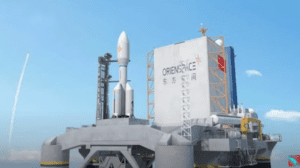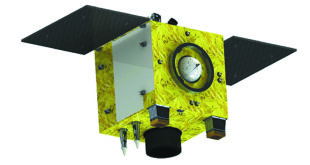by Blaine Curcio and Jean Deville
 As part of the partnership between SpaceWatch.Global and Orbital Gateway Consulting we have been granted permission to publish selected articles and texts. We are pleased to present “Dongfang Hour China Aerospace News Roundup 15 – 21 November 2021”.
As part of the partnership between SpaceWatch.Global and Orbital Gateway Consulting we have been granted permission to publish selected articles and texts. We are pleased to present “Dongfang Hour China Aerospace News Roundup 15 – 21 November 2021”.
Hello and welcome to another episode of the Dongfang Hour China Aero/Space News Roundup! A special shout-out to our friends at GoTaikonauts!, and at SpaceWatch.Global, both excellent sources of space industry news. In particular, we suggest checking out GoTaikonauts! long-form China reporting, as well as the Space Cafe series from SpaceWatch.Global. Without further ado, the news update from the week of 15 – 21 November 2021.
1) Haiyang Oriental Spaceport going big on sea launch
Jean’s Take
 CAS Space, a commercial launch spin-off of the Chinese Academy of Sciences, has been developing the ZK-1A solid-fueled rocket for 2-ish years now, and has been in the past few weeks testing its erector vehicle, basically transferring the rocket from its transport vehicle to the erector, and the using the latter to put the 200t rocket from a horizontal to a vertical position, and back (video dating back to october 18). The ZK-1A could be land launched, but we know that it most certainly be sea-launched: the Oriental Space Port of coastal city of Haiyang in Shandong Province held a ceremony a couple weeks ago on Oct. 30 for the construction of a new type of ship for sea launch, which would be 162.5 meters long and 40 meters wide. The images showed a rocket that looked very much like a ZK-1A. The ship was reported to be available in 2022, which coincides well with the first launch of the ZK-1A, apparently in March 2022 with no less than 6 satellites as the payload, according to a recent WeChat post.
CAS Space, a commercial launch spin-off of the Chinese Academy of Sciences, has been developing the ZK-1A solid-fueled rocket for 2-ish years now, and has been in the past few weeks testing its erector vehicle, basically transferring the rocket from its transport vehicle to the erector, and the using the latter to put the 200t rocket from a horizontal to a vertical position, and back (video dating back to october 18). The ZK-1A could be land launched, but we know that it most certainly be sea-launched: the Oriental Space Port of coastal city of Haiyang in Shandong Province held a ceremony a couple weeks ago on Oct. 30 for the construction of a new type of ship for sea launch, which would be 162.5 meters long and 40 meters wide. The images showed a rocket that looked very much like a ZK-1A. The ship was reported to be available in 2022, which coincides well with the first launch of the ZK-1A, apparently in March 2022 with no less than 6 satellites as the payload, according to a recent WeChat post.
So it seems that Haiyang Space Port is really becoming something big in China. It was already in charge of pioneering sea launch with the successful sea launch of the Long March 11 in 2019 and 2020 from different modified sea platforms. CALT’s commercial subsidiary, called China Rocket, also set up a subsidiary in Haiyang in April 2021 to manufacture the Jielong solid fueled rockets, likely for sea launch as well.
Finally, another company called Ospace has been showing sea launch illustrations for its future Gravity series of rockets, so another potential rocket company doing sea launch, although we do not know if this will be in Haiyang.
Perhaps most of interest about this Haiyang Space Port is that at the Oct 30 ceremony linked to the construction of the sea launch ship, it mentioned that it would support small to medium lift solid and liquid-fueled sea launch, and even better, it would support launch vehicle recovery.
And this description of liquid-fueled rocket launch capability and recovery does not really match with the Jielong, Long March 11, or the ZK-1A rockets mentioned previously. So there is definitely a mystery. BUT thanks to a recent photo published by CAS Space last week on the erector vehicle test, we may have an answer. Blaine, do you want to tell us all about that?
And on a related note, around the time of the CAS Space launch, we saw some impressive sleuthing from the always insightful Cosmic Penguin on Twitter. Notably, in the background of photos of the TEL test, we saw a blurred out image that looked suspiciously like…..a Zhuque-2 liquid methalox rocket from Landspace. Soon after, we saw some equally impressive sleuthing from the Ace of Razgriz, who pointed out that the two rockets could be seen on Google Maps, where one of them is clearly a Landspace rocket.
As noted by Cosmic Penguin, this brings up some questions, chiefly why is the ZQ-2 seemingly being primed to launch near/from the sea? And, will Haiyang end up developing the necessary infrastructure to allow for methalox launches? For the latter, the launch facility would need to build supporting infrastructure, including capacity for dozens of cryogenic fuel trucks to ship fuel to the launch site, or alternatively infrastructure to produce cryogenic fuel on site. There would also need to be additional fueling systems for cryogenic rockets, adding more complexity.
Up to now, we have not heard any news about Landspace and Haiyang, Shandong Province (the location of the TEL test, and of the ZQ-2 rocket), so to that extent, one has to give them credit for really flying under the radar about this. That being said, Landspace has been pretty stealthy in general these couple of years, so we may well end up seeing them doing some incredible things in a pretty unexpected fashion over the coming handful of months.
Finally, it’s also interesting to see multiple Chinese commercial launch companies using the same facility for their testing. As we’ve noted before, Landspace is among China’s most well-established commercial launch companies, and CAS Space, despite having been founded far more recently (December 2018!), has moved very rapidly, which is an indication of the support they are receiving from the Chinese Academy of Sciences.
And from launch to international cooperation, we saw a pretty big event a couple of weeks ago that’s worth breaking down a little bit.
2) China-Africa BeiDou Conference and a discussion on Digital Silk Road
Blaine’s Take
Actually from earlier this month, we saw the First China-Africa BeiDou System Cooperation Forum, held in Beijing on Friday 5 November. The forum saw representatives from 48 African countries, including no less than 8 Government Ministers and 8 ambassadors to China. The event called for increasing cooperation between China and Africa in developing Beidou applications, a phrase we have heard used before in other regions including Southeast Asia. The event was hosted at the offices of China Great Wall Industry Corporation, which as we discussed on the Dongfang Hour Beijing Deep Dive Episode, is located in a beautiful former hotel near a quasi-mythical garden. Great place to hold a forum.
A variety of high-level Chinese space industry figures gave speeches, including He Yubin, Chairman of the China Satellite Navigation System Committee, Xu Hongliang, Secretary General of the China National Space Administration, and Wu Jianghao, Assistant Minister of Foreign Affairs. African speakers included the Senegalese Minister of Digital Economy and Telecommunications Ndèye Tické Ndiaye Diop, Africa Union Head of Science & Technology Mahama Ouedraogo, and Felix Moloua, the Minister of Planning, Economy, and Cooperation of the Central African Republic (NB: we cannot be 100% sure of the African speaker’s names. Their names were translated into Chinese in the article, and we tried to backtrack by finding people with very similar titles and similar-sounding names. We did our best). Among other things, speakers interestingly noted the “Africa 2063” Project, a 50-year plan to create a more developed and equal Africa.
The forum comes at an important time as China’s Belt and Road Initiative, and notably the Digital Silk Road (the digital component of BRI) are starting to face increasing pressure, or at a minimum, decreasing momentum, as questions about debt sustainability arise, and as the political situation in certain key countries along the BRI (such as Ethiopia, which has been a major beneficiary of Chinese investment) deteriorate rapidly. Both debt burdens and humanitarian disasters are calling into question the sustainability of the projects being done by China in these regions. That being the case, digital projects become even more important, in the sense that in this day and age, it’s probably easier to close the business case for a new 5G (or 3G/4G, as the case may be) network in a developing country than it would be for a railway, airport, or other physical infrastructure.
As we have noted before, in the space sector specifically, China appears to be moving away from “selling huge pieces of expensive hardware” (like telecommunications satellites costing hundreds of millions of US$) towards selling “applications”, oftentimes using Chinese-launched hardware. The most obvious example of this would be Beidou, where China has launched a global satnav constellation, and is now encouraging countries to use Beidou-compatible chips and other hardware to develop location-based service applications. More recently, we have seen more Chinese EO companies trying to commercialize their data abroad, and in the future, we will likely see a LEO broadband mega-constellation launched, with broadband services/applications being commercialized across the Belt and Road.
Moving forward, we expect to see China continue to roll out digital infrastructure in developing countries, including many along the Belt and Road. As the world increasingly goes digital, and as there are only a couple of countries that can plausibly provide full stack of digital services (namely US, China, and very debatably Europe), we are likely to see a continued digital land grab, whereby China and US companies/governments try to forge digital alliances in third countries, both as a proactive measure for one’s own national interests, and in some cases, as a blocking measure to the other party’s national interests.
While China’s Beidou ties in Africa are still less strong than, for example, Southeast Asia (where Thailand and Cambodia, among others, have received Beidou-related investment), we expect to see more Chinese involvement on the continent in the future.
For a deeper-dive into the Digital Silk Road, we recommend a great podcast conversation on the China-Africa Podcast with Jonathan Hillman from the Center for Strategic and International Studies (CSIS) in Washington DC. Hillman spoke with the podcast about his recent book, The Digital Silk Road: China’s Quest to Wire the World and Win the Future. The talk with Hillman not only gives a great overview of what the Digital Silk Road is, but also provides a fascinating comparative reference by discussing how these projects are being received in Washington DC.
3) Ye Peijian Discusses China’s Lunar Ambitions
Jean’s Take
China’s top-level space program veteran Ye Peijian gave a 30-min interview to CCTV last week, which was fascinating to analyze and brings up a lot of topics as to why China is pursuing a space program, the place of competition with the US, and China’s future deep space exploration ambitions.
Before getting into that, a brief portrait of Ye Peijian. People talk a lot about Chinese space but rarely the people who are behind it. China often displays its space program as a collective effort and you have perhaps fewer very visible people like Elon Musk, Jeff Bezos, …; yet there are some recurring names: Ouyang Ziyuan, Luan Enjie, Zhang Kejian or Long Lehao. And Ye Peijian is also definitely one of them.
Ye Peijian is a 76-year old top level space engineer, who began his career in satellite manufacturing in the late 1960s, and whose career grew spectacularly starting from the 1980s after joining CAST. He became chief commander and engineer of the 2nd generation Ziyuan EO satellites in the 1990s, and after 2001 he held increasingly important positions in China’s lunar program, eventually becoming chief engineer & designer of the Chang’e missions. In 2003, he was elected to the title of academician of the CAS, and was awarded the honorary title of People’s Scientist by Xi Jinping in 2019. In other words, this guy is one of the most respected space people in China, and his words are definitely worth analyzing. Speaking of which, let’s get back to the interview.
I think one highlight is when Ye Peijian discusses the motivations behind China’s space program. When the journalist asks him what’s the point of the space program, he mentions that while the objective of China’s space exploration program is most definitely space sciences, geopolitical reasons are increasingly playing an important role. Basically, space is an important tool of asserting superpower status, and notably versus the US which has, according to Ye, “repeatedly taken an arrogant stance” vis-à-vis China on space achievements.
And this brings us to a very frequently discussed topic: Is there a space race between China and the leading space superpower, the US ? The Chinese narrative of this question is usually that the space race approach is something the US has started, and exacerbated notably with mechanisms like the Wolf amendment that excludes any collaboration between NASA and China. There is also this opinion among China space watchers that China has its own agenda, sets its goals years and sometimes decades in advance, and has no interest in taking part in a space race.
But I think Ye Peijian’s interview tends to contradict this a little bit, to suggest another story. There was an important moment where he notably said: “别人做的,我们也要做,别人没做的,我们也要做,别人已经做得好的,我们将来想办法超过”.
What this shows is that definitely space exploration breakthroughs are considered as very important geopolitical tools to demonstrate superpower status, and to be on equal footing with the US.
Ye Peijian goes further, and expands to space tech in general, saying that space has become a matter of national security, and not just a commercial investment where you consider only ROI.
All of this tends to join a previous Ye Peijian statement in 2017 where he famously mentioned that “the universe is the ocean, and the moon is like the Diaoyu Islands. If we don’t go now, our descendants will blame us.” (Diaoyu islands are islands where China has territorial claims). And to understand this statement, you have to look at the world from a Chinese perspective. China thinks that today’s world, and territories, and geopolitics were shaped to a large extent by the 18th so early 20th century, a period where China where did not play a very active role (for various reasons linked to Qing dynasty history that we discuss here), and that it is still paying the consequences of those mistakes. And as a consequence, China would need to be proactive in space for the geopolitics of the future (space resources which seem to have little value today could be extremely important in the future).
Now, having said all this, I think it’s important to ask ourselves, what’s the representativeness of Ye Peijian’s opinions here, is it one man’s opinion or is it the general feeling of the space establishment?
I would tend to think the latter. This is my personal opinion, but I think there is a general and genuine concern in China that China may be deprived of space resources in the future by the US. We’ve heard similar concerns during China’s deep space exploration forum that took place in Shenzhen in October, as well as in a recent interview of the co-CEO of Ospace, Yao Song, who mentioned that “Space resources are first-come, first-served, first-occupied, first-served. If we don’t go now, the sky will be locked up in the future”.
I think it would be wrong to reduce China’s space program to geopolitics and prestige operations. While there is definitely quite a bit of that, I’m convinced (as a former aerospace engineer) that space sciences remain the dominating driving force. I think the space industry in China tends to be filled with people passionate about what they are doing, especially as aerospace doesn’t pay too well in China. And I think Ye Peijian sort of hints at this when he says that a lot of aerospace engineers are in a “金不换” state of mind (lit. “would not trade their position even for gold”). There was a recent TV series in China called You Are My Glory that embodies that pretty well.
There were also other points discussed in Ye Peijian’s interview, notably on upcoming space exploration timelines, but for the sake of keeping this episode contained, let’s just leave it here and you can check out our newsletter for a deeper dive.
4) ADA Space Announces B-Round
Blaine’s Take
Commercial satellite operator ADA Space announced on Saturday an RMB355M (~US$55M) B-round of funding, with funding coming from multiple Guangdong-based funds, namely Shenzhen Oriental Fortune Capital and Dongguan Financial Holdings. ADA Space is noteworthy for having launched a number of “Xingshidai” satellites, as part of their ADACloud project. The funding round announcement did not specify how the money would be allocated, but this represents one of the largest funding rounds for a Chinese commercial satellite manufacturer. A big congrats to ADA Space!
This has been another episode of the Dongfang Hour China Space News Roundup. If you’ve made it this far, we thank you for your kind attention, and look forward to seeing you next time! Until then, don’t forget to follow us on YouTube, Twitter, or LinkedIn, or your local podcast source.
Blaine Curcio has spent the past 10 years at the intersection of China and the space sector. Blaine has spent most of the past decade in China, including Hong Kong, Shenzhen, and Beijing, working as a consultant and analyst covering the space/satcom sector for companies including Euroconsult and Orbital Gateway Consulting. When not talking about China space, Blaine can be found reading about economics/finance, exploring cities, and taking photos.
Jean Deville is a graduate from ISAE, where he studied aerospace engineering and specialized in fluid dynamics. A long-time aerospace enthusiast and China watcher, Jean was previously based in Toulouse and Shenzhen, and is currently working in the aviation industry between Paris and Shanghai. He also writes on a regular basis in the China Aerospace Blog. Hobbies include hiking, astrophotography, plane spotting, as well as a soft spot for Hakka food and (some) Ningxia wines.





